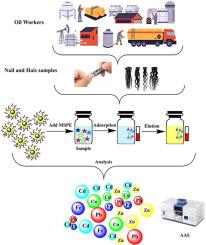Engineered methionine-functionalized magnetic nanobiocomposites for precision biomonitoring of petroleum-driven heavy metal contamination in occupational and environmental health
IF 6
2区 化学
Q1 CHEMISTRY, ANALYTICAL
引用次数: 0
Abstract
Background
Environmental biomonitoring of petroleum-linked heavy metal exposure remains challenging due to limitations in sensitivity, selectivity, and matrix complexity of conventional methods. This study bridges this gap by engineering methionine-functionalized magnetic nanoparticles (Fe3O4@SiO2@CPTES@Methionine) for precision monitoring. Leveraging methionine's dual-function groups, the nanoplatform selectively preconcentrates trace lead (Pb) and cadmium (Cd) from human hair/nails prior to AAS quantification. This approach specifically targets exogenous contamination from petroleum activities, distinguishing it from endogenous elements (Cu, Zn, Fe). The method enables direct linkage of industrial pollution to human exposure, addressing critical needs in occupational/environmental health.
Results
The nanobiocomposite achieved ultra-trace detection limits (0.003–0.03 mg/kg) and high recovery (>95 %) across all target metals, validated using certified reference materials (98–102 % recovery). Analysis revealed significantly elevated Pb (0.8–3.0 mg/kg) and Cd (0.2–0.6 mg/kg; p < 0.05) accumulation in oil field workers compared to non-exposed controls (Pb: 0.1–0.5 mg/kg; Cd: 0.03–0.1 mg/kg), directly implicating petroleum operations. In contrast, endogenous Cu (7.8–11.2 mg/kg), Zn (110–165 mg/kg), and Fe (12.3–28.1 mg/kg) levels showed no significant inter-cohort differences, confirming metabolic regulation over exogenous input. The nanoplatform demonstrated reusability (>3 cycles) without performance loss.
Significance
This work establishes a transformative, nanotechnology-enabled biomonitoring tool that precisely links petroleum-driven heavy metal contamination to human exposure. Its high sensitivity, selectivity, and reusability offer a scalable strategy for real-time occupational risk assessment, pollution source tracking, and environmental health management in resource-extraction zones. The methodology bridges advanced material design with practical global health applications, providing a definitive tool for exposure attribution and supporting ecological sustainability.


工程蛋氨酸功能化磁性纳米生物复合材料用于职业和环境健康中石油驱动重金属污染的精密生物监测
由于传统方法在灵敏度、选择性和基质复杂性方面的局限性,石油相关重金属暴露的环境生物监测仍然具有挑战性。这项研究通过工程蛋氨酸功能化磁性纳米颗粒(Fe3O4@SiO2@CPTES@Methionine)进行精确监测,弥补了这一差距。利用蛋氨酸的双功能基团,纳米平台在原子吸收分光光度法(AAS)定量之前,选择性地从人类头发/指甲中预富集微量铅(Pb)和镉(Cd)。这种方法专门针对来自石油活动的外源性污染,将其与内源性元素(Cu, Zn, Fe)区分开来。该方法能够将工业污染与人类接触直接联系起来,解决职业/环境健康方面的关键需求。结果该纳米生物复合材料在所有目标金属中均具有超痕量检出限(0.003 ~ 0.03 mg/kg)和高回收率(95%),使用标准物质进行验证(回收率98 ~ 102%)。分析显示,与未暴露的对照组(Pb: 0.1-0.5 mg/kg; Cd: 0.03-0.1 mg/kg)相比,油田工人体内Pb (0.8-3.0 mg/kg)和Cd (0.2-0.6 mg/kg; p < 0.05)的积累显著增加,直接影响石油作业。相比之下,内源性Cu (7.8-11.2 mg/kg)、Zn (110-165 mg/kg)和Fe (12.3-28.1 mg/kg)水平在队列间无显著差异,证实了外源性输入对代谢的调节。纳米平台证明了可重用性(3个周期),而没有性能损失。这项工作建立了一种变革性的、纳米技术支持的生物监测工具,可以精确地将石油驱动的重金属污染与人类暴露联系起来。它的高灵敏度、选择性和可重用性为资源采掘区的实时职业风险评估、污染源跟踪和环境健康管理提供了可扩展的策略。该方法将先进的材料设计与实际的全球健康应用相结合,为暴露归因和支持生态可持续性提供了明确的工具。
本文章由计算机程序翻译,如有差异,请以英文原文为准。
求助全文
约1分钟内获得全文
求助全文
来源期刊

Analytica Chimica Acta
化学-分析化学
CiteScore
10.40
自引率
6.50%
发文量
1081
审稿时长
38 days
期刊介绍:
Analytica Chimica Acta has an open access mirror journal Analytica Chimica Acta: X, sharing the same aims and scope, editorial team, submission system and rigorous peer review.
Analytica Chimica Acta provides a forum for the rapid publication of original research, and critical, comprehensive reviews dealing with all aspects of fundamental and applied modern analytical chemistry. The journal welcomes the submission of research papers which report studies concerning the development of new and significant analytical methodologies. In determining the suitability of submitted articles for publication, particular scrutiny will be placed on the degree of novelty and impact of the research and the extent to which it adds to the existing body of knowledge in analytical chemistry.
 求助内容:
求助内容: 应助结果提醒方式:
应助结果提醒方式:


